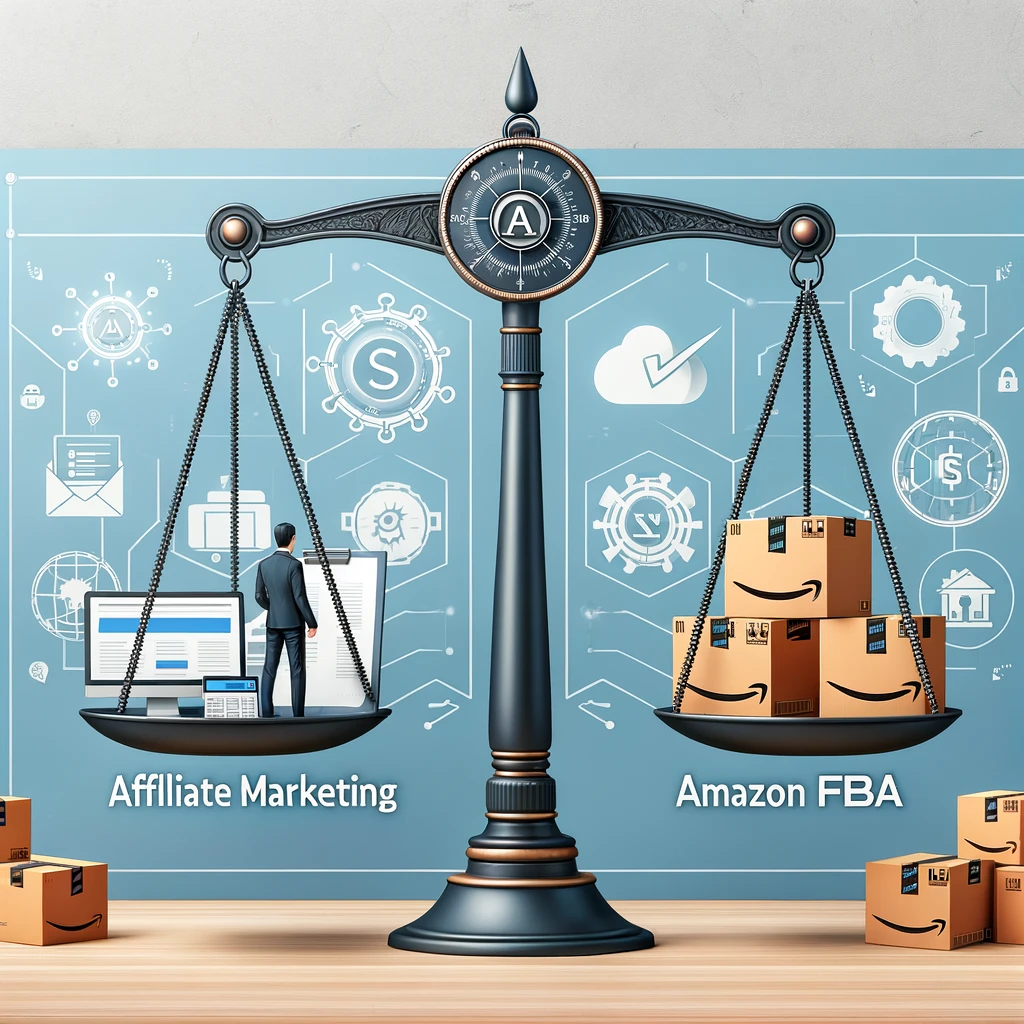Affiliate Marketing vs Amazon FBA: Pros and Cons Explained

Affiliate marketing vs Amazon FBA, which one wins the internet marketing battle! I’ve been doing both for over a decade and both are popular ways to make profits online. Both have their perks and challenges, but which one is right for you in terms of tools, time, and money? Affiliate marketing involves promoting products and earning commissions, while Amazon FBA lets you sell physical products using Amazon’s vast network, tools, and website for your online business.
This post will dive into the key differences between affiliate marketing and Amazon FBA in online business. We’ll explore how each model works, the potential earnings, and what it takes to succeed in both. Whether you’re a newbie or looking to switch gears, understanding these two options can help you save time, money, and make an informed decision along the way.
I’m currently doing both strategies, so it really isn’t necessary to pick one over the other. So, keep that in mind as you read this article.
Key Takeaways
-
Understand Your E-commerce Model: When considering affiliate marketing vs. Amazon FBA, it’s crucial to understand the ins and outs of each model to make an informed decision that saves time and money along the way.
-
Affiliate Marketing is Low-Risk: Affiliate marketing requires minimal upfront investment of time and money, making it an ideal way for those who prefer a low-risk entry into e-commerce.
-
Amazon FBA Offers Scalability: With Amazon FBA, you can scale your business more easily due to Amazon’s massive infrastructure and customer base, saving time and money.
-
Know the Challenges: Both models come with their own set of challenges, including time and money. Affiliate marketing can be competitive, while Amazon FBA can involve high fees, inventory management, time, and money.
-
Choose Based on Your Strengths: If you excel in content creation and digital marketing, affiliate marketing might be your best bet for making money. If you prefer handling products and logistics, and don’t mind paying upfront for inventory, than Amazon FBA could be more suitable for making money.
-
Consider Combining Both: For maximum success, consider combining both models for more money. Use affiliate marketing to drive traffic and Amazon FBA to drive sales and have Amazon assist with fulfillment.
Understanding E-commerce Models
E-commerce Defined
E-commerce refers to buying and selling goods or services online. It’s significant because it allows businesses to reach a global audience. People can shop from anywhere, anytime and the percentage who are making transactions online is only going to go up.
Evolution of E-commerce
E-commerce has evolved rapidly. Initially, it was just about listing products online. Now, it’s about creating engaging customer experiences. Digital entrepreneurship is on the rise. Many prefer starting an online business over traditional retail.
Traditional Retail vs Modern Platforms
Traditional retail involves physical stores. Customers visit these stores to buy products. It requires managing inventory and dealing with product returns in person.
Modern e-commerce platforms use technology to simplify the process
-
Online stores manage inventory digitally.
-
The fulfillment process is automated.
-
Product returns are handled efficiently.
These platforms provide a better customer experience. They offer convenience and a wider range of products.
Role of Technology
Technology plays a crucial role in modern e-commerce. It helps in:
-
Managing inventory
-
Tracking customers’ preferences
-
Enhancing the shopping experience
Businesses use data analytics to understand their customer base better. This helps in personalizing offers and improving sales.
Customer Experience
Customer experience is vital in e-commerce. Happy customers are likely to return and recommend the store to others. Online businesses focus on making the shopping process smooth and enjoyable.
Exploring Affiliate Marketing
Basics Explained
Affiliate marketing involves promoting products from other companies. Affiliates earn a commission for every sale made through their referral links. Key players include the merchant, the affiliate, and the customer.
Affiliates use various methods like blogs, social media, email marketing, to reach audiences. They don’t handle inventory or customer inquiries. Instead, they focus on driving traffic to the merchant’s site.
Passive Income Potential
Affiliate marketing offers a chance for passive income. Affiliates can earn money by promoting products without holding stock. Once content is created and shared, it can generate sales over time.
This method allows individuals to make money while they sleep. Successful affiliates often build a steady stream of income by continuously adding valuable content.
Low Start-Up Costs
Starting with affiliate marketing requires minimal investment. There are no costs for inventory or shipping. Most expenses go towards website hosting and domain names.
This model is ideal for those new to e-commerce. It provides a low-risk way to enter the market without significant financial commitment.
Flexibility
Affiliate marketing offers great flexibility in terms of work hours and location. Affiliates can work from anywhere with an internet connection. This makes it appealing for digital nomads or those seeking work-life balance.
Creating content can be done at any time of day. This allows affiliates to fit their work around other commitments easily.
Commission Rates
Commission rates vary depending on the marketplace and product category. Some niches offer higher commissions than others. For example:
-
Retail products may have lower commission rates.
-
Digital products often provide higher percentages.
-
Niche markets can offer lucrative opportunities for skilled marketers.
It’s important to research different programs and choose those that align with your interests and expertise.
Content Creation Importance
Content creation is vital in affiliate marketing success. High-quality content attracts visitors and builds trust with audiences. Affiliates must produce engaging articles, videos, or social media posts regularly.
Effective content addresses audience needs and solves problems. This approach encourages clicks on referral links and increases conversion rates.
Diving into Amazon FBA
Product Selection
Choosing the right product is crucial. Start by researching market trends and customer needs. Tools like Jungle Scout can help identify profitable products. Avoid overly saturated markets to increase your chances of success.
Inventory Management
Amazon FBA requires upfront investment in inventory. You need to purchase products in bulk. Keep track of stock levels to avoid running out or overstocking. Good inventory management software can streamline this process.
Shipping Logistics
Amazon handles shipping for you. Once your products are ready, send them to an Amazon fulfillment center. They take care of storage, packaging, and delivery. This eliminates the hassle of managing shipping yourself.
Buy Box Advantage
The Buy Box is a coveted spot on Amazon’s product pages. Winning it increases sales significantly. While many sellers can be on one listing, only one seller gets the buy box at a time. Factors influencing this include pricing, seller rating, and fulfillment method. Using FBA often boosts your chances.
Customer Base
Amazon has millions of customers worldwide. Leveraging their platform gives you access to a vast audience without extensive marketing efforts. This can lead to higher sales and brand visibility.
Initial Investment
Starting an Amazon FBA business requires significant capital. Costs include purchasing inventory, shipping fees, and Amazon’s service charges. It’s essential to budget carefully and plan for these expenses. While many courses and so called gurus will tell you that you need to invest thousands of dollars in a private label product to be successful, there are many other approaches like buying a handful of products at a local retailer or online that can lead to success. A “mile wide and an inch deep” is often times a better approach than going all in! Test a lot of different products at low quantities first before going in deep!
Fulfillment by Amazon (FBA)
FBA simplifies many aspects of running an online store. Amazon handles returns, customer service, and logistics. This allows you to focus on other parts of your business like marketing and product development.
Affiliate Marketing vs Amazon FBA: Differences Highlighted
Active vs Passive
Amazon FBA requires active involvement. Sellers must manage inventory, handle customer orders, and track shipments. This means spending many hours ensuring everything runs smoothly.
In contrast, affiliate marketing is more passive. Affiliates promote products through content like blog posts or social media. They don’t handle inventory or shipping.
Inventory Needs
With Amazon FBA, you need to maintain a lot of inventory. You must store items in Amazon’s warehouses and keep track of stock levels.
Affiliate marketing has no inventory requirements. Affiliates earn commissions by driving traffic to other people’s stores or products.
Scalability
Amazon FBA offers scalability but with limitations. You can grow your business by expanding your product list and increasing stock. However, managing more products means more work and higher costs.
Affiliate marketing scales easily with less effort. By creating more content and attracting more visitors, you can increase earnings without added responsibilities. Many who are successful with affiliate marketing seek high ticket products to promote allowing them to make much more money. However, many times conversion rates are lower for high ticket products/courses, so keep that in mind.
Business Control
Control varies between the two models. With Amazon FBA, sellers have control over their store and product listings. They can adjust prices, descriptions, and images as needed.
Affiliate marketers have less control. They rely on the merchant’s site for conversions and depend on the merchant’s policies. If you can drive people to your own landing page and “warm-up” the potential customer and potentially offer bonuses to those who buy through your affiliate link, you could have a higher chance of success with affiliate marketing.
Start-Up Costs
Start-up costs differ significantly between these models:
-
Amazon FBA: Requires investment in inventory, storage fees, and shipping costs.
-
Affiliate Marketing: Minimal start-up costs. Mostly involves creating a website or social media presence.
Profit Margins
Potential profit margins also vary:
-
Amazon FBA: Higher potential profits but also higher risks due to upfront investments.
-
Affiliate Marketing: Lower risk but generally lower profit margins per sale since affiliates earn commissions only.
Advantages of Affiliate Marketing
Low Barrier to Entry
Affiliate marketing requires minimal upfront investment. Unlike Amazon FBA, there is no need to purchase inventory. You can start with just a computer and internet connection. This makes it accessible for anyone interested in earning online.
Passive Income Potential
Earning income 24/7 is a significant benefit. Once you set up your affiliate links, they work around the clock. You don’t need to be actively involved in sales or customer service. This allows you to earn money even while you sleep.
Scalability
Affiliate marketing scales easily. Growth does not require additional inventory or logistics. You can promote more products without worrying about storage or shipping. This makes it easier to expand your business.
High Profit Margins
Profit margins are generally higher in affiliate marketing. There are no costs associated with manufacturing or shipping products. This means more of the revenue goes directly into your pocket.
Freedom and Flexibility
Affiliate marketing offers freedom and flexibility. You can work from anywhere with an internet connection. There is no need to adhere to strict schedules or locations. This fits well with those seeking a balanced lifestyle.
Leveraging Social Media
Social media platforms enhance your online presence. They allow you to reach a broader audience quickly and effectively. Using social media for advertising features helps increase sales and drive traffic to your affiliate links.
No Customer Service Hassles
Handling customer service can be time-consuming and stressful. In affiliate marketing, this responsibility falls on the product owner, not you. This frees up time for other activities or expanding your business efforts.
Advantages of Amazon FBA
Extensive Customer Base
Amazon’s FBA program provides access to a vast customer base. Millions of shoppers visit Amazon daily. This exposure can boost your sales significantly. Prime members often prefer products with Prime shipping, increasing the likelihood of purchase.
Prime Shipping and Service
FBA sellers benefit from Amazon’s Prime shipping. Fast, free shipping attracts more buyers. This service also includes handling returns and customer inquiries. Customers trust Amazon’s service, leading to higher satisfaction rates.
Storage Convenience
Using Amazon’s fulfillment centers means you don’t need your own storage space. They handle inventory management for you. This allows you to focus on marketing and growing your business without worrying about logistics.
Reduced Shipping Costs
Amazon negotiates lower shipping rates due to its volume. These savings are passed on to FBA sellers. Lower shipping costs can increase your profit margins. It’s a significant advantage over self-fulfillment options.
Focus on Sales and Marketing
With logistics handled by Amazon, you can concentrate on sales strategies. More time can be spent on advertising and customer engagement. This focus can lead to better brand recognition and increased revenue.
Higher Profit Margins
Selling directly through Amazon can lead to higher profit margins. The platform is trusted by customers, which often results in higher prices for products compared to other marketplaces. Direct sales eliminate middlemen, maximizing profits.
Challenges of Each Model
Market Saturation
Both Amazon FBA and affiliate marketing face intense competition. Many sellers and affiliates crowd these spaces. Amazon FBA has millions of sellers, making it tough to stand out. New products can get lost in a sea of similar items. Affiliates also deal with market saturation. Popular niches have countless affiliates promoting the same products.
Scalability Issues
Scaling an Amazon FBA business can be tricky. As sales grow, so do inventory needs. Managing larger inventories requires more capital and storage space. Amazon’s guidelines must be followed strictly, adding another layer of complexity. Affiliates face different scalability challenges. They need to constantly create fresh content to attract traffic and maintain commissions.
Inventory Management
Amazon FBA sellers must manage their inventory carefully. Overstocking can lead to high storage fees, while understocking results in missed sales opportunities. Sellers must predict demand accurately and reorder stock timely. Adhering to Amazon’s strict guidelines is crucial for maintaining seller status.
Costs Involved
Both models come with costs that affect profitability. For Amazon FBA, initial investment includes product sourcing, shipping, and storage fees. Additional costs arise from advertising and returns handling. Affiliate marketing might seem cheaper initially but involves ongoing expenses for website maintenance, content creation, and marketing tools.
Commission Hijacking
Affiliate marketers face the risk of commission hijacking. Competitors may use unethical methods to steal commissions by replacing affiliate links with their own. This practice reduces potential earnings for honest affiliates.
Revenue Fluctuations
Revenue fluctuations are common in both models but more pronounced in affiliate marketing. Commissions depend on traffic and conversion rates which can vary greatly month-to-month due to changes in search engine algorithms or consumer behavior patterns.
Choosing the Right Path for Newbies
Personal Strengths
Assessing personal strengths is crucial. If you excel in writing and content creation, affiliate marketing might be better. It involves promoting products on a blog or social media. On the other hand, if you are good at logistics and handling inventory, Amazon FBA could be more suitable.
Interests
Consider your interests. Affiliate marketing allows you to promote products you are passionate about. This can make the process enjoyable. Amazon FBA requires interest in sourcing and selling physical products. Both paths need dedication.
Investment Capabilities
Investment capabilities matter too. Affiliate marketing has a lower initial cost. You can start with minimal investment by creating a blog or using social media platforms. Amazon FBA requires more capital for inventory and shipping costs.
Market Research
Market research is essential in both models. For affiliate marketing, find a niche with high demand and low competition. Tools like Google Trends can help identify trends.
For Amazon FBA, researching new markets is key. Use tools like Jungle Scout to analyze product demand and competition on Amazon.
Niche Selection
Choosing the right niche impacts long-term success. In affiliate marketing, select a niche that aligns with your interests and has a sizable audience. Popular niches include health, technology, and finance.
In Amazon FBA, choosing profitable niches is critical. Look for products with consistent sales but low competition.
Customer Support
Customer support differs between the two models. Affiliate marketers often rely on customer service from the companies they promote. They don’t handle returns or complaints directly.
Amazon FBA sellers must provide customer support themselves or use Amazon’s services. This includes handling returns and addressing customer complaints.
Learning Curve
Both models have learning curves but differ in complexity. Affiliate marketing’s learning curve involves mastering SEO, content creation, and audience engagement.
Amazon FBA’s learning curve includes understanding logistics, inventory management, and navigating Amazon’s seller platform.
Starting Small
Starting small is wise for beginners with limited capital. Affiliate marketing is ideal for this approach as it requires less upfront investment. Build an audience first before considering bigger investments.
Transitioning to Amazon FBA can happen once experience is gained in online selling and market dynamics are understood better.
Combining Both for Success
Maximize Revenue
Combining affiliate marketing with Amazon FBA can maximize revenue. Affiliate marketing drives traffic to your Amazon listings. This increases product visibility and sales.
Affiliate links embedded in blogs or social media posts can redirect users to your Amazon store. This is a great way to boost traffic without significant investment.
Increase Product Visibility
Affiliate marketing enhances product visibility. Affiliates promote your products on various platforms. This creates more touchpoints for potential customers.
Increased visibility often leads to higher sales. More people see your products, increasing the chances of purchases.
Cross-Promotion Potential
Cross-promotion is another benefit of combining these models. You can use your Amazon FBA listings in affiliate promotions. This taps into different customer bases.
For example, you could write a blog post about a product you sell on Amazon. Include an affiliate link to drive traffic and sales simultaneously.
Diversified Income Streams
Integrating both models diversifies income streams. Relying on just one method limits growth potential. Combining them provides multiple revenue sources.
This strategy reduces risk if one model underperforms. It ensures steady income from different channels.
Leverage Strengths
Leverage the strengths of both models for success. Affiliate marketing offers flexibility and low initial investment. Amazon FBA handles fulfillment and support, saving time and effort.
Using both allows you to focus on what you do best while outsourcing other tasks. This balance maximizes efficiency and profitability.
Final Remarks
You’ve explored the ins and outs of both affiliate marketing and Amazon FBA. Each has its perks and pitfalls, but ultimately, your choice depends on your goals and resources. Affiliate marketing offers flexibility and low startup costs, while Amazon FBA provides control over inventory and branding.
Ready to take the plunge? Whether you go with affiliate marketing, Amazon FBA, or a mix of both, the key is to start now. Dive in, learn as you go, and adapt to what works best for you. Got questions or need more tips? Drop a comment below—we’re here to help you succeed!
Frequently Asked Questions
What is the main difference between affiliate marketing and Amazon FBA in the fulfillment process of an online business?
Affiliate marketing promotes other people’s products for a commission. Amazon FBA involves selling your own products, with Amazon handling storage and shipping.
Which model requires more upfront investment?
Amazon FBA generally requires more upfront investment for inventory and storage fees. Affiliate marketing has lower startup costs as you don’t need to purchase inventory.
Can I do both affiliate marketing and Amazon FBA simultaneously for my online business and passive income?
Yes, combining both can diversify income streams. It allows leveraging different e-commerce strategies to maximize revenue.
Which model is easier for beginners?
Affiliate marketing is often easier for beginners due to its low startup costs and minimal risk. It doesn’t require managing physical products or inventory.
What are the primary benefits of Amazon FBA?
Amazon FBA offers extensive reach via Amazon’s marketplace, hassle-free logistics, and customer service management. It scales well with growing demand.
Are there any major challenges in affiliate marketing?
Yes, competition is high, requiring effective SEO tactics and continuous content creation to drive traffic and conversions.
How do I decide which model, tools, and advertising features are right for me?
Assess your budget, risk tolerance, and business goals. If you prefer low-risk ventures with minimal investment, start with affiliate marketing. For higher control over products and branding, consider Amazon FBA.


